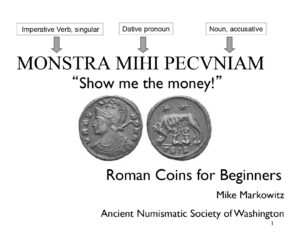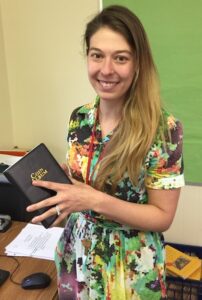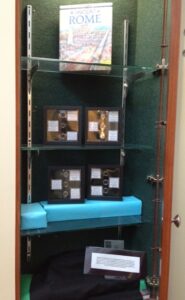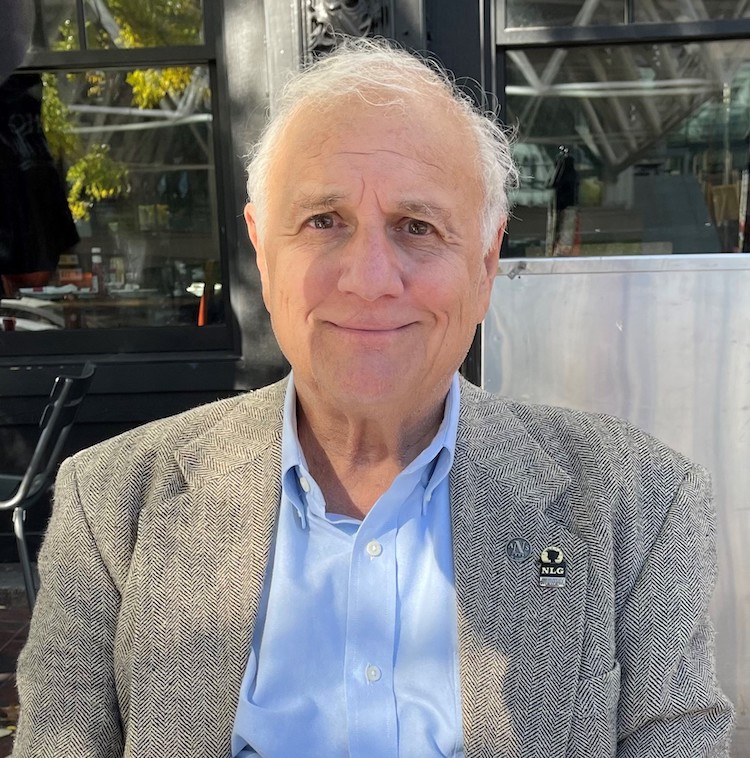
Mike Markowitz is a defense analyst and wargame designer for the U.S. military by trade, but his avocation is collecting ancient Byzantine gold coins. Mike focuses on more than his own collection; he also devotes substantial amounts of his free time to learning more about all types of ancient and medieval coins so he can pursue outreach efforts aimed at teaching others about them. As “Second Counsel” for the Ancient Numismatic Society of Washington, D.C. and Vice President of the Fairfax Coin Club in Virginia, Mike has planned and given educational programs about ancient and medieval coins geared to fellow collectors. Mike has also written extensively about particular coin issues and the ancient cultures that made them for “CoinWeek.com,” an online publication. However, Mike’s most rewarding efforts relate to using ancient Roman coins as teaching tools for kids.

Christie Lovelette, Latin teacher, uses history and artifacts to bring Latin to life for her students. Courtesy Christie Lovelette.
Latin students at the Hill School in Middleburg, Va., are just one group that has benefited from Mike’s expertise. In their case, Mike’s lecture is just part of a much more comprehensive program. The Hill School’s Latin teacher, Dean of Students Christie Lovelette, integrates genuine ancient Roman coins into her lesson plan to further engage her students.
Budding Latin scholars work with actual ancient Roman coins, which they are tasked to identify, learning something about the emperors and the culture that made them in the process. The coins that are utilized for this purpose are typically small, late Roman bronze coins that were issued in massive numbers during the Fourth Century A.D. The obverse of such coins features Imperial portrait busts of the first Christian Emperor, Constantine the Great, or members of his family, as well as their Imperial rivals. Reverses may depict either pagan or Christian religious imagery or military themes meant to convey the strength and foresight of the Roman State. These coins make great teaching tools not only because they are a testament to an important period in Roman history, but because they are readily available on the market for as little as $10.00. Each student gets his or her own ancient Roman coin to identify. The coins are then displayed in small shadow boxes around the classroom for all to see.
Typically, Mike’s lectures to different grades have taken place before the students are given their own coin to identify. These talks have provided much needed context about how such coins were made, how they were used, and why so many exist today. One lecture, entitled “Show Me the Money,” provided an overview of how Roman coinage developed over time. Another discussed typical “heads” and “tails” designs on late Roman coinage. A third discussed the Roman economy and the place of coins within it. A fourth provided a more general overview of collecting ancient Roman coins.

Display of books and coins for students.
Given the subject matter, Mike always focuses on how the Latin legends found on the coins combine with their imagery to further Imperial “messaging.” The Empire may have been constantly at war with marauding Germanic tribes, but coins showing a Roman legionary spearing a fallen barbarian and proclaiming FELicium TEMPorum REPARATIO, meaning “re-establishment of the happy times” (happy days are here again!) were good for morale.
The author of this article has accompanied Mike during some of his visits to the Hill School. It was rewarding to see not only the obvious interest of the students in Mike’s lecture, but the fun learning experience they received by actually getting to handle ancient coins. Mike represents some of what is best in numismatics by giving his lectures to students not only at the Hill School, but at other schools around the Washington, D.C. area. Other collectors should follow his lead.
Next Installment: Your Tax Dollars at Work
More about Mike’s Writing on Ancient and Medieval Coins
Expert Columns, Michael Markowitz, CoinWeek.com, Academia.edu, Mike Markowitz Papers.
[1] Peter K. Tompa is a semi-retired lawyer who resides in Washington, D.C. He has written extensively about cultural heritage issues, particularly those of interest to the numismatic trade. Peter contributed to Who Owns the Past?” (K. Fitz Gibbon, ed. Rutgers 2005). He formerly served as executive director of the Global Heritage Alliance and now is a member of its board of directors. (https://global-heritage.org/) This article is a public resource for general information and opinion about cultural property issues and is not intended to be a source for legal advice. Any factual patterns discussed may or may not be inspired by real people and events.
 Mike Markowitz, volunteer teacher of history through the medium of ancient coins. Courtesy Mike Markowitz.
Mike Markowitz, volunteer teacher of history through the medium of ancient coins. Courtesy Mike Markowitz. 

